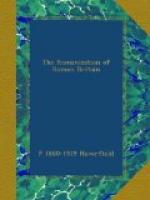[Footnote 1: Tile inscribed NERCLCAEAVGGER, Nero Claudius Caesar Augustus Germanicus (Eph. ix. 1267). It differs markedly from the ordinary tiles found at Silchester, and plainly belongs to a different period in the history of the site. Possibly the estate, or whatever it was, did not remain Imperial after Nero’s downfall; compare Plutarch, Galba, 5. The Combe Down Principia (C. vii. 62), which are certainly not military, may supply another example, of about A.D. 210 (Vict. Hist. Somerset, i. 311; Eph. ix. p. 516).]
[Footnote 2: Hirschfeld in Lehmann’s Beitraege zur alten Geschichte, ii. 307, 308. Much of the Gaulish domain land appears to date from confiscations in A.D. 197.]
Throughout all the rest of the British province, or at least of its civilized area, the local government was probably organized on the same cantonal system as obtained in northern Gaul. According to this system the local unit was the former territory of the tribe or canton, and the local magistrates were the chiefs or nobles of the tribe. That may appear at first sight to be a native system, wholly out of harmony with the Roman method of government by municipalities. Yet such was not its actual effect. The cantonal or tribal magistrates were classified and arranged just like the magistrates of a municipality. They even used the same titles. The cantonal civitas had its duoviri and quaestors and so forth, and its ordo or senate, precisely like any municipal colonia or municipium. So far from wearing a native aspect, this cantonal system merely became one of the influences which aided the Romanization of the country. It did not, indeed, involve, like the municipal system, the substitution of an Italian for a native institution. Instead, it permitted the complete remodelling of the native institution by the interpenetration of Italian influences.
We can discern the cantonal system at several points in Britain. But the British cantons were smaller and less wealthy than those of Gaul, and therefore they have not left their mark, either in monuments or in nomenclature, so clearly as we might desire. Many inscriptions record the working of the system in Gaul. Many modern towns—Paris, Reims, Chartres, and thirty or forty others—derive their present names from those of the ancient cantons, and not from those of the ancient towns. In Britain we find only one such inscription (Fig. 15),[1] only one town called in antiquity by a tribal name—and that a doubtful instance[2]—and no single case of a modern town-name which is derived from the name of a tribe.[3] We have, however, some curious evidence from another source. There is a late and obscure Geography of the Roman Empire which was probably written at Ravenna somewhere about A.D. 700, and which, as its author’s name is lost, is generally quoted as the work of ‘Ravennas’. It consists for the most part of mere lists of names,




